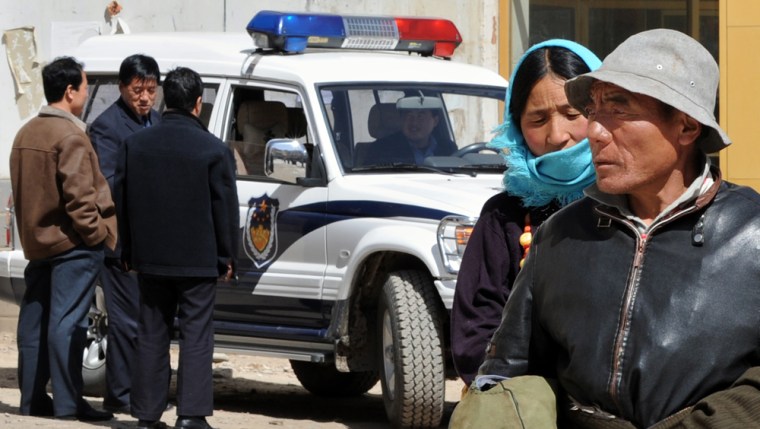Soldiers and police have been deployed around two Buddhist monasteries in Tibet's capital where monks launched protests against Chinese rule earlier this week, witnesses and residents said Thursday.
A man who answered the phone at the Sera monastery in Lhasa said monks have been confined inside its walls, shut off from outside contact, and are relying on dwindling food supplies.
The monastery was "surrounded by many people," said the man, who refused to identify himself or say whether he was a monk.
Another Lhasa resident, who also refused to be identified, said the Drepung monastery was encircled by "three layers" of army personnel while the Sera monastery had been surrounded by more than 2,000 police.
The resident said more than 10 trucks filled with soldiers, nearly a dozen police cars and also ambulances were seen heading to the area.
A Foreign Ministry official in Beijing had no immediate comment late Thursday on the reported police and military presence.
It is extremely difficult to get independent verification of events in Tibet since China maintains rigid control over the area. Foreigners need special travel permits, and journalists are rarely granted access except under highly controlled circumstances.
Bold challenge
Large-scale demonstrations by the Buddhist monks began Monday, as they staged a bold, public challenge to China's rule using the anniversary of a failed Tibetan uprising against Beijing rule in 1959.
Demonstrations also spilled over into traditionally Tibetan areas in the neighboring province of Qinghai. Monks at two other monasteries -- the Lutsang monastery and Ditsa monastery -- also held small protests but were not detained by police, according to U.S. government-funded Radio Free Asia.
An official in the Bureau of Religious Affairs in Guinan County, where Lutsang is located, confirmed that protests had taken place at the monastery.
"For the past few days, we have been on high alert for protests and other formal gatherings by monks as this has been a widespread occurrence," said the official, who refused to give his name.
Earlier Thursday, Foreign Ministry spokesman Qin Gang confirmed that protests had taken place, but said the situation had "stabilized." Qin accused exiled Tibetan spiritual leader the Dalai Lama of inciting separatism, though he provided no evidence.
"In recent days, a few monks in Lhasa city have made some disturbances," Qin said at a regular news briefing.
"This is a political scheme by the Dalai group, attempting to separate China and try to make some unrest in the normal harmonious, peaceful life of Tibetan people," he said.
Further protests banned
Qin also said China's determination to "safeguard national unification" is firm, so further protests "will not take place."
In the Lhasa protests, the involvement of monks from Sera and Drepung is seen as particularly provocative. The monasteries traditionally trained Buddhist scholars who led theocratic Tibet before China supplanted the Dalai Lama and the rest of the theocracy.
After two demonstrations Monday -- one in which 300 or more monks from Drepung marched on the streets of the capital, the other in which a smaller groups of monks from Sera protested -- police arrested an unknown number of protesters, according to reports and witnesses.
On Tuesday, police used tear gas to disperse an estimated 500 to 600 monks from the nearby Sera monastery who were marching to demand the release of imprisoned fellow monks, Radio Free Asia reported.
Protests in Lhasa this week are believed to be the largest in the city since Beijing crushed a wave of pro-independence demonstrations in 1989.
Beijing maintains that Tibet is historically part of China, but many Tibetans argue the Himalayan region was virtually independent for centuries and accuse China of trying to crush Tibetan culture by swamping it with Han people, the majority Chinese ethnic group.
Exiles arrested in India
Meanwhile, police in India detained more than 100 Tibetan exiles as they marched to their homeland Thursday in protest of China's hosting of the Olympic Games.
The protesters began a hunger strike within hours of being arrested, Tenzin Palkyi, a march coordinator, told The Associated Press.
The protesters shouted "Free Tibet!" and other slogans as they were being detained, but there was no violence, witnesses said. Senior police official Atul Fulzele said the protesters had been charged with threatening the region's "peace and tranquility."
But organizers vowed to continue the march.
"We will have to find a way," said Tenzin Palkyi, one of the march coordinators. "Our legal team will deal with the police."
Indian officials fear the march could embarrass Beijing and banned the exiles from leaving the Kangra district that surrounds the northern Indian city of Dharmsala, the headquarters of the Tibetan government-in-exile.
Nine foreigners who were marching with the Tibetans but were not arrested began a hunger strike of their own outside the building where the Tibetans were being held. The foreigners hail from the United States, Scotland, Germany, Poland and Australia.
